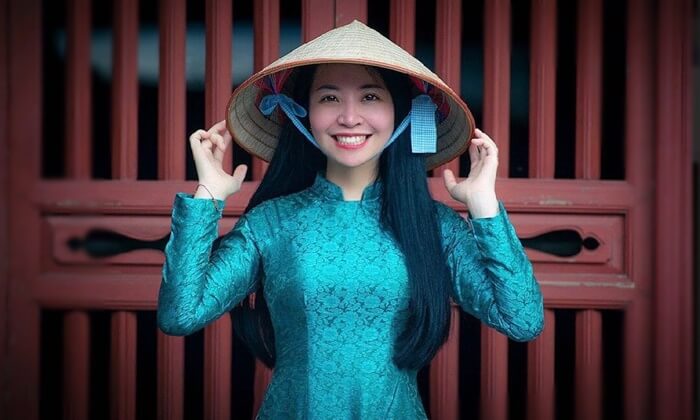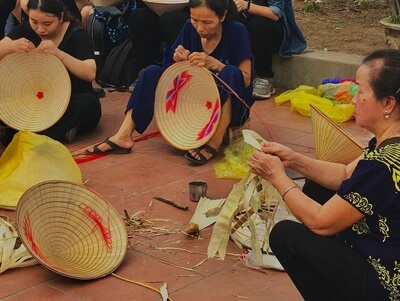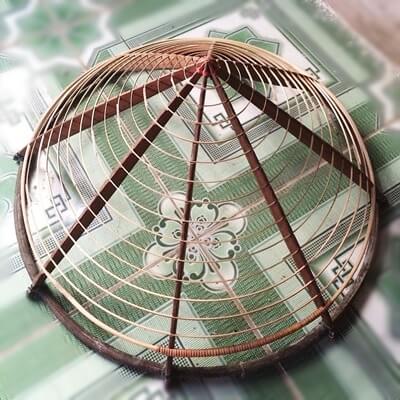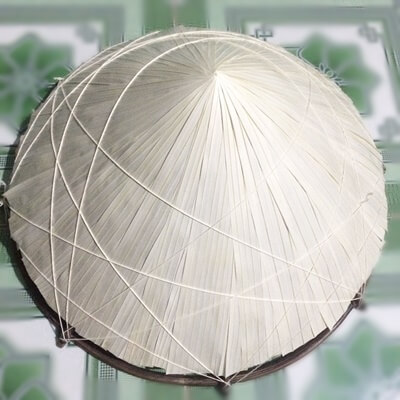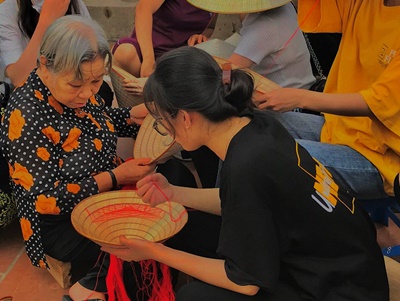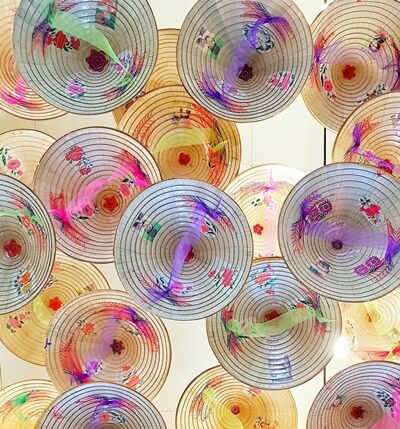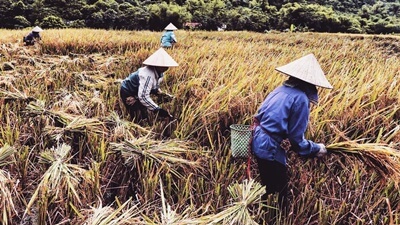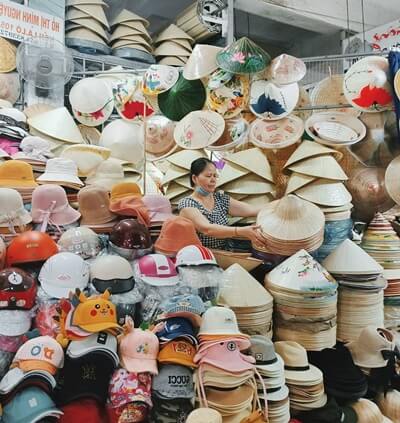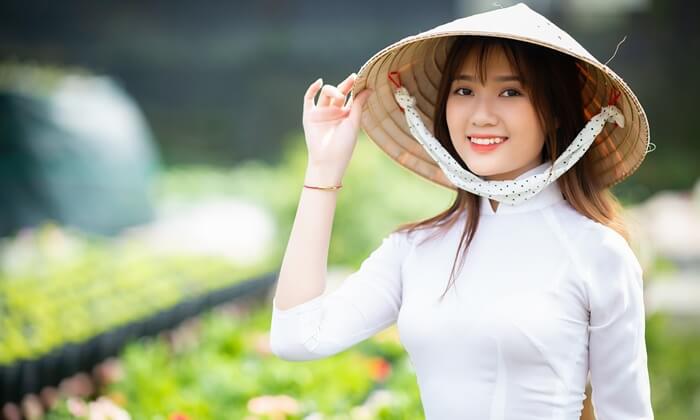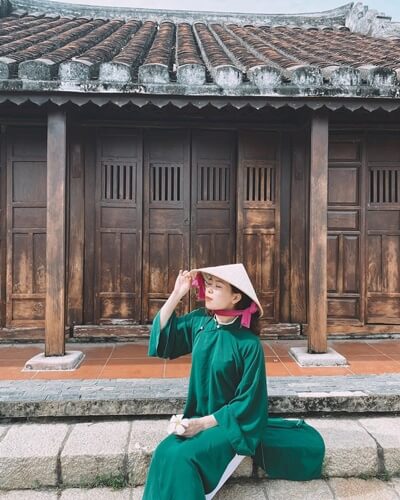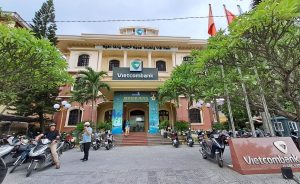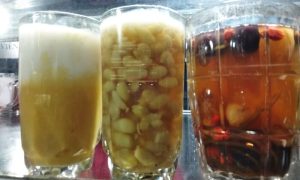The Vietnamese hat known as Nón lá is an iconic cultural symbol. Nón means “hat,” and lá means “leaf,” referring to a “leaf hat.” This name highlights the hat’s construction from various leaves, including palm, banana, and coconut, with palm leaves being the most common.
These leaves are intricately placed and attached to bamboo frames, forming the distinctive conical shape, hence the alternate name, “conical hat.”
Nón lá has become a quintessential symbol in Vietnamese culture, particularly associated with women and the traditional Ao Dai.
History of appearing Vietnamese hat
Where is the conical hat from? Since ancient times, Vietnamese people have known how to put leaves together to get typical things to cover the head and face. This covering helped them live better under the influence of the tropical monsoon climate with a lot of rain and sunshine.
This item has become the first simple hat people wear to cover their heads from the sun and rain.
The traditional Vietnamese hat gradually became a necessary item in daily life. Conical hats are made from simple and readily available materials, such as palm, bamboo, and coconut leaves.
Despite being made from simple materials, the Vietnamese conical hat, through the skilled hands of artisans, has transcended its practical use to become a symbol of tradition in many villages for centuries.
According to Vietnamese history, conical hats were invented around the 13th century under the Tran Dynasty. At that time, they were used to make accessories for rich women, but they were quite thick and heavy. With the passage of time, the hat became lighter and more elegant.
Conical hats have had many stages of change in their shape, from the round flat hat in the ancient North to the round conical hat in Hue City and Central Vietnam. A conical hat is commonly used because of its solid contouring appearance, improved aesthetics, and conical depth to protect against rain and sun.
Despite its evolution, the Vietnamese conical hat has remained a staple in the daily lives of the Vietnamese people for generations. Its cultural significance is evident in its portrayal in literature and poetry, where it is often used as a symbol of Vietnamese identity.
>> You may want to know about clothing in Vietnam.
How to make conical hats
The main materials used to make a Vietnamese hat are mainly palm or coconut leaves, bamboo stalks, thread, etc.
Step 1: Choosing leaves
The first step in making a hat is choosing leaves. Many types of leaves can be used, but Vietnamese people often use coconut or palm leaves. Coconut leaves must come from the South, while palm leaves are abundant in the North.
The leaves are dried in the sun, and then the workers flatten them with a heated iron. The iron must be just hot enough not to burn the leaves.
Step 2: Creating a frame and sharpening bamboo sticks
Next is the process of making a frame for hats and sharpening bamboo sticks. The craftsmen sharpen each stick so that it is round evenly.
Typically, people try to make these sticks very small in diameter so that they are easy to bend without breaking.
A complete hat will have about 16 bamboo spokes bent into large and small circles arranged in a pyramidal frame. The number 16 symbolizes the most beautiful time in a woman’s lifetime.
However, conical hats for Buddhist monks will have 18 bamboo spokes, which says that the Buddhist people want to keep the bustling life away when wearing big hats.
Step 3: Put the dry leaves on the hat frame
After the leaves are made flat and the conical mold is completed, people arrange about 24-25 leaves on top of each other in 2 layers.
To put all the leaves on the frame, workers cut one head of leaves diagonally and sew this head together with a needle.
People add dry banana leaves, paper, or pictures to the middle of the two layers, becoming the third ordinary layer, making the hat hard and durable.
This step seems simple, but it requires many techniques to make it even and not displaced.
Step 4: Sewing the Vietnamese hat
The final step is to sew the hat. The craftsman uses a thread and a sewing needle to keep the leaf layers together.
They often stitch each stitch through several layers to create a beautiful cone shape.
Although there is no specific measurement for each stitch on the hat, it is neat, showing the ingenuity and professionalism of the hat maker. The stitching joints on the hat are also guaranteed to be perfectly concealed.
After finishing the stitching, the craftsman will add a flower made of colorful thread to the inside top of the hat to make it more beautiful.
The hat is finished after being coated with a thin layer of glossy plastic paint. This skill can prevent rainwater from going through the pinholes on the hat.
Finally, the hat is dried again to increase its durability.
Step 5: Add the strap to the conical hat
Inside the conical hat, additional straps create symmetry on both sides, which helps users wear it easily and prevent it from falling off.
The hat strap can be made of normal fabric, velvet fabric, or silk in different colors to enhance the wearer’s appearance.
Different types of Vietnamese hats
Vietnamese conical hats have different types according to each historical period. However, many kinds of hats are not suitable, so now there are a few types that exist:
- Palm-leaf hats: The most popular type in Vietnam is made of palm leaves and bamboo frames. It has a pointed pyramid shape and a strap.
- Coconut-leaf hats, a unique variation found predominantly in the South of Vietnam, particularly in the Mekong region, offer a regional twist to the traditional conical hat.
- Nón Quay Thao: Quay Thao hats are made of palm leaves and have wide, flat brims. This type is popular in the North and is only used for decoration or festivals.
- Hue Poem hats: These hats are also made of palm leaves. But, between two layers of leaves, there are poems and pictures about Hue City.
- La Bang hats (nón lá bàng), a recent addition to the conical hat family, are a testament to the artisan’s skill and creativity. Crafted from the meticulously treated leaves of Terminalia catappa, these hats are a sight to behold, often used for decoration or performing arts.
When do the Vietnamese people wear hats?
Vietnamese traditional hats are worn for most jobs, such as working in the fields, going to the market, and going out.
However, today, there has been a change in fashionable style; not many Vietnamese people wear conical hats as popularly as before.
Despite changing fashion trends, the enduring cultural significance of the conical hat is evident in the rice fields, where farmers continue to wear them.
And, when some girls take pictures in a traditional long dress, the Vietnamese conical hat is an indispensable accessory.
Vietnamese people also use conical hats to decorate their homes, restaurants, or cafes.
In the past, cyclists could wear conical hats, but today, this is not allowed because of the danger. Therefore, you need to pay attention when riding a bicycle in Vietnam; you should not wear conical hats.
How much is a conical hat in Vietnam?
The price of Vietnamese hats varies depending on their unique types, quality, and the different regions in Vietnam where they are crafted, adding to their allure and intrigue.
At Ben Thanh Market, souvenir stalls sell conical hats, each adorned with a myriad of eye-catching patterns and images, offering a thrilling visual experience. The hats come in different sizes and cost 80,000 to 200,000 VND.
In particular, hats with hand-embroidered pictures, landscape paintings, or knitted bamboo slats are favorite models. Ancient-style hats are often used as performance props and have the highest selling price: 200,000 – 300,000 VND.
This price can increase at some high-end fashion stores, but it is never a popular item.
In Dong Ba Market in Hue City, you can find many Vietnamese conical hats, typically Nón Bài Thơ—Poem conical hats. The price per one ranges from 60,000 VND to 100,000 VND.
Nowadays, people who come to buy conical hats are mainly tourists. They buy them as souvenirs from Vietnam. The local people also have bought them, but not much because of changing fashionable thinking.
Vietnamese conical-hat villages
Many conical hat villages in Vietnam, each preserving the unique image of the conical hat, are a testament to the dedication of their workers. The hats, each with the distinct characteristics of their region, are all crafted with unwavering commitment.
In the North, it is famous for making hats with Chuong conical village (Làng Chuông) located about 40km from the center of Hanoi in Thanh Oai District.
The conical hat of Chuong village was born in 1940, and many generations still maintain the traditional model. The special feature of Chuong Village’s conical hat is white palm leaves. These leaves are taken from the mountainous areas of Thanh Hoa and Ha Tinh and dried in the sun until they are silvery white.
Along the central region, conical hats flourished in the ancient capital of Hue, which had many conical villages such as Da Le, Phu Cam, and Doc So. The characteristics of Hue conical hats are high-quality products and masterpiece works of art, the most unique of which is the poem conical hat.
In the South, the over 70-year-old Thoi Tan hat village in Can Tho, made of bamboo and typical leaves of local trees – Mật Cật, is a living testament to the region’s rich history. These materials make the hats look smooth and durable.
Thoi Tan Villagers also divide hats into two types, including going-to-market hats and working-in-field hats. The market hats are a more carefully selected type in the leaves, much more elaborate than the field hats.
A traditional conical hat is a simple object, but it contains a lot of meaningful cultural values for Vietnamese people. Indeed, when visiting the S-shaped country, holding a conical hat in hand, you will have exciting impressions and experiences.
So, it would help if you spent your holidays, when you have a chance, exploring the charm of conical hats on the Vietnam map.
